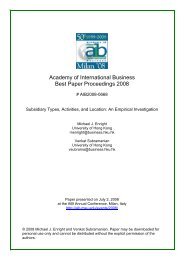AIB 2012 Conference Proceedings - Academy of International ...
AIB 2012 Conference Proceedings - Academy of International ...
AIB 2012 Conference Proceedings - Academy of International ...
You also want an ePaper? Increase the reach of your titles
YUMPU automatically turns print PDFs into web optimized ePapers that Google loves.
MONDAY<br />
proposed. (For more information, please contact: Hamid Yeganeh, Winona State University, USA:<br />
hyeganeh@winona.edu)<br />
How Do Top Managers and Powerful External Actors Affect the Relationship between Resistance and Adoption<br />
<strong>of</strong> Diffusing Practice An Integrating Framework<br />
Qian Lu, National University <strong>of</strong> Singapore<br />
Jieyu Zhou, Hong Kong University <strong>of</strong> Science and Technology<br />
We provide a framework to examine how resistance impacts firm's adoption <strong>of</strong> new diffusing practice. In our<br />
framework, Firm's adoption toward the new practice is classified according to two dimensions: completeness <strong>of</strong><br />
implementation and fidelity <strong>of</strong> framing. We argue that the relationships among firm's resistance and the two<br />
ends <strong>of</strong> adoption are affected by different agents: Top manager's perception <strong>of</strong> the new practice moderates the<br />
effect <strong>of</strong> resistance on completeness <strong>of</strong> implementation, while resistance's influence on fidelity <strong>of</strong> framing<br />
depends on powerful external actors' perception toward the new practice. The national system serves as the<br />
boundary condition for the framework. (For more information, please contact: Qian Lu, National University <strong>of</strong><br />
Singapore, Singapore: luqian@nus.edu.sg)<br />
Session: 2.4.15 - Interactive<br />
Track: 3 - IB Theory, FDI, and Entry Mode<br />
MNEs from Emerging Markets, MNEs in Emerging Markets<br />
Presented On: July 2, <strong>2012</strong> - 14:30-15:45<br />
Chair: Jiawen Yang, George Washington University<br />
FDI Outflows and Domestic Investment in the BRIC Countries: An Empirical Exercise<br />
Nandita Dasgupta, UMBC<br />
The emerging economies such as Brazil, Russia, India and China (BRIC) are aggressively pursuing international<br />
investment practices through outbound foreign direct investment (OFDI) activities since the implementation <strong>of</strong><br />
their outward looking development strategies. The increasing FDI outflows from these countries have naturally<br />
raised concerns relating to the repercussions on their domestic investment and capital formation from the<br />
perspective <strong>of</strong> economic development and growth. The concern arises because OFDI activities could shift not<br />
only some <strong>of</strong> the production activities from home to foreign destinations but also could possibly threaten the<br />
availability <strong>of</strong> scarce financial resources at home by allocating resources abroad. All this have the potential to<br />
reduce domestic investment, thus lowering the long run domestic economic growth and employment. The<br />
central goal <strong>of</strong> this paper is to empirically investigate and evaluate the evidence <strong>of</strong> the macroeconomic<br />
relationship between OFDI and levels <strong>of</strong> domestic capital formation in the BRIC economies. This study is<br />
carried out in two broad steps. The first step is a time series data analysis where we have performed country<br />
level exercise to estimate the causal relationship between OFDI and domestic investment in each <strong>of</strong> the four<br />
BRIC countries. Given the limitations on data availability, we had to restrict ourselves to a bivariate analysis with<br />
gross capital formation (GCF: measure <strong>of</strong> domestic investment) and OFDI as the only two variables. In the next<br />
step, we have employed a balanced panel <strong>of</strong> four BRIC countries over the period <strong>of</strong> 19 years from 1992 through<br />
2010. The choice <strong>of</strong> our variables is basically from the Feldstein (1995) model, which includes FDI inflows and<br />
outflows, domestic savings as well as other variables that might jointly influence domestic investment. (For<br />
more information, please contact: Nandita Dasgupta, UMBC, USA: nandita@umbc.edu)<br />
<strong>AIB</strong> <strong>2012</strong> <strong>Conference</strong> <strong>Proceedings</strong><br />
Page 183

















